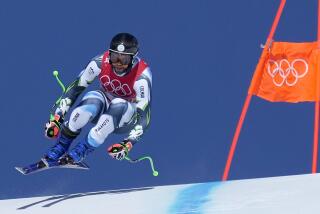SKIING : Knauss Finds His Niche on Slopes of Pro Tour
- Share via
TAHOE CITY, Calif. — Austrian skier Bernhard Knauss was never able to score any World Cup points or earn an Olympic medal for his homeland, but he seems to have found a new home on the U.S. Pro Tour.
On a sunny day at Alpine Meadows, the 24-year-old racer shrugged off shoulder and knee injuries to win Saturday’s giant slalom, the first race of a $60,000 weekend event labeled America’s Opening Cup.
This was also the first race on an expanded and enriched circuit that will take the pros back and forth across the country a couple of times, as well as to Canada and Japan.
Actually, most of the racers began the season two weeks ago at Molltal, Austria, in a non-scoring event. Knauss won the giant slalom there, too.
With 35 or so races between now and the final stop April 5-8 at Aspen, Colo., a skier could theoretically win as much as $875,000 this winter. Total prize money will be in excess of $2 million for the first time.
Of course, it is unlikely that anyone, even Knauss, who wound up fifth overall as a rookie last season, will sweep every race. For one thing, he has to contend with Phil Mahre, the United States’ three-time World Cup champion, in today’s slalom.
Last season, his first as a pro, Mahre won nine races--eight slaloms and just one giant slalom--as he finished second overall, behind Jorgen Sundqvist of Sweden.
On Saturday, Mahre, 32, was eliminated by Austrian Werner Herzog in the round of 16.
Mahre, the 1984 Olympic slalom gold medalist, seemed unconcerned, saying: “I’ve only been training on skis for a few days. The slalom is another race.”
Said Yugoslav Tomaz Cerkovnik, who lost the final to Knauss when he skied off the course on the second of their two head-to-head runs: “Don’t let Phil kid you. He and Steve always show up for a race claiming they haven’t had time to ski. Then they go out and beat you.”
Steve Mahre, who is also on the tour, skipped this meet to tend to the twins’ other business interests. Phil will return the favor for the Heavenly Valley races on Jan. 4-7. Otherwise, they both plan to make all of the remaining stops, including Snow Summit, near Big Bear Lake, on Jan. 25-28.
Unlike Olympic and World Cup competition, in which skiers come down the course one at a time against the clock, pro racing starts with a field of 32 and matches two skiers on parallel courses that include a couple of spectator-pleasing jumps. The winner is determined by the total time differential for two runs, usually measured in thousandths of a second.
Thus, Knauss had to defeat five opponents, skiing two runs against each of them.
“I only skied in five races for the Austrian national team,” he said. “I think I am better suited to the pro format, which requires more endurance.”
In the quarterfinals, Knauss fell at the end of his second run and banged up his left shoulder and right knee but continued racing. “In the next round, it hurt quite a bit,” he said, “but after that it wasn’t too bad.”
Helping Knauss to build up his endurance--and presumably, his tolerance to pain--last summer on the Alpine glaciers was Koni Rupprechter, an Austrian who formerly coached the women downhillers on the U. S. Ski Team. Now, Rupprechter has a mini-team of Austrians under his wing, marking the first time there has been such an organization on the traditionally individualistic pro circuit.
More to Read
Go beyond the scoreboard
Get the latest on L.A.'s teams in the daily Sports Report newsletter.
You may occasionally receive promotional content from the Los Angeles Times.






